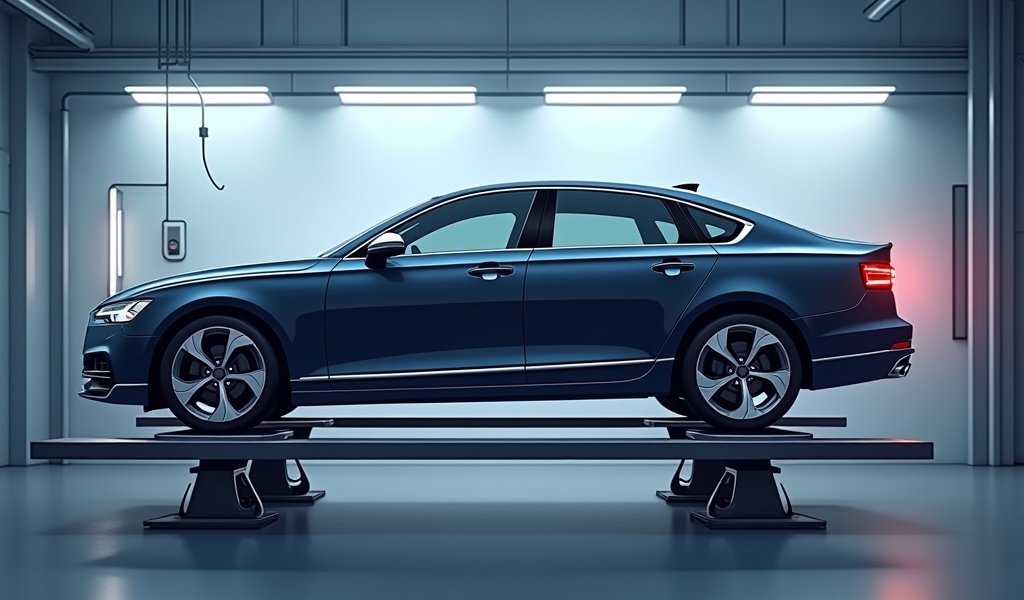Overview
The article explains the critical difference between wheel alignment (adjusting suspension components for proper wheel angles) and tire balancing (ensuring even weight distribution), offering five key maintenance tips: timely alignments, regular balancing, proper tire inflation, consistent rotation, and prompt suspension repairs. These practices can extend tire life by up to 50% (9,000-15,000 extra miles), improve vehicle safety and handling, and save significant money compared to premature tire replacement.
Table of Contents
- Understanding the Difference: Alignment vs Balancing
- Tip #1: Know When to Get Wheel Alignment
- Tip #2: Don’t Ignore Balancing Needs
- Tip #3: Maintain Proper Tire Pressure
- Tip #4: Rotate Tires Regularly
- Tip #5: Address Suspension Issues Promptly
- Conclusion
- Frequently Asked Questions
Your tires are the only point of contact between your vehicle and the road, making them one of the most critical components affecting safety, performance, and fuel economy. Yet many drivers overlook simple maintenance practices that could extend tire life by up to 50%. Knowing the difference between wheel alignment and balancing is essential for maximizing your tire investment and ensuring a smooth, safe ride.
As a master technician with over 20 years in the field, I’ve seen countless tires scrapped prematurely due to neglected alignment and balancing. The average driver spends $400-$800 per set of tires, but with proper care, you could add 9,000-15,000 miles to their lifespan. That’s real money staying in your pocket.
Let’s demystify these two crucial services and explore five practical tips that will help you maximize tire life, improve handling, and enhance your vehicle’s safety.
Understanding the Difference: Alignment vs Balancing
Though often confused, wheel alignment and tire balancing are entirely different services addressing separate aspects of tire wear and vehicle performance.
Wheel alignment involves adjusting the angles of your wheels to match the manufacturer’s specifications. We’re not actually adjusting the tires or wheels themselves, but rather the suspension components that control wheel positioning. When properly aligned, your tires make even contact with the road, preventing uneven wear patterns and ensuring your vehicle drives straight without pulling to one side.
Think of alignment as setting the position of your wheels relative to each other and to the vehicle. We measure and adjust three primary angles:
- Camber: The inward or outward tilt of the tire when viewed from the front
- Caster: The forward or backward tilt of the steering axis
- Toe: Whether the tires point inward or outward when viewed from above
Tire balancing, on the other hand, addresses weight distribution around the wheel assembly. Even minor imbalances (as little as half an ounce) can cause noticeable vibrations at highway speeds. During balancing, I attach small weights to the wheel to ensure even distribution as it rotates.
You’ll likely need alignment if your vehicle pulls to one side, shows uneven tire wear, or your steering wheel sits crooked when driving straight. For balancing, the telltale sign is vibration that typically becomes noticeable at highway speeds (50-70 mph) and might be felt in the steering wheel, floorboard, or seat.
While different services, alignment and balancing work together as part of a comprehensive car service checklist to ensure proper tire contact with the road. Both are essential for maximizing tire life and vehicle performance.

Tip #1: Know When to Get Wheel Alignment
Proper wheel alignment is crucial for even tire wear and optimal handling. From my experience in the shop, here are the key indicators that your alignment needs attention:
- Your vehicle pulls to one side when driving on a straight, level road
- Uneven or unusual tire wear patterns, especially on the inner or outer edges
- Your steering wheel is off-center when driving straight
- You notice increased tire noise or steering wheel vibration
- The vehicle feels “loose” or wandering on the highway
Most manufacturers recommend checking your alignment annually or every 15,000 miles under normal driving conditions. However, certain events warrant immediate alignment checks:
- After hitting a significant pothole or curb
- Following any collision, even minor fender benders
- When installing new tires
- After suspension work or modifications
Don’t wait until you see severe tire wear to check your alignment. By then, you’ve already significantly reduced your tire’s lifespan. A professional alignment service typically costs between $75-$200 depending on your vehicle type—a small investment compared to premature tire replacement.
According to Car and Driver’s research, proper wheel alignment can improve fuel economy by up to 10% and extend tire life by thousands of miles. That’s significant savings over the life of your vehicle.
Tip #2: Don’t Ignore Balancing Needs
Tire balancing is often overlooked until vibrations become severe enough to make your morning coffee dance out of the cup holder. By then, your tires have already experienced accelerated wear that can’t be undone. I’ve seen countless customers surprised by how much smoother their vehicle drives after a simple balancing service.
Common signs that your tires need balancing include:
- Vibration that increases at specific speed ranges (typically 50-70 mph)
- Vibration felt primarily in the steering wheel (front tire imbalance) or seat/floorboard (rear tire imbalance)
- Scalloped or cupped wear patterns on your tires
- Excessive wear on suspension components or bearings
- Steering wheel shimmy that comes and goes at different speeds
Industry standards suggest balancing tires every 5,000-7,000 miles or when you rotate your tires. Balancing is also necessary whenever a tire is removed from the rim, such as during a flat repair or when replacing a tire.
The cost of tire balancing typically runs between $40-$75 for a full set, making it one of the most cost-effective maintenance procedures relative to the benefits it provides. Many shops offer free lifetime balancing when you purchase tires from them—a valuable perk worth asking about when choosing the right tires for your vehicle.
Remember, balanced tires not only wear more evenly but also provide a smoother ride, reduce stress on your suspension components, and can even improve fuel economy slightly. That’s a lot of benefit for a quick service that takes less than an hour.
Tip #3: Maintain Proper Tire Pressure
In my 20+ years turning wrenches, I’ve seen countless alignment and balancing jobs undermined by the simplest issue: improper tire pressure. This is perhaps the easiest aspect of tire maintenance, yet the most frequently neglected.
Underinflated tires flex excessively and wear more heavily on the outer edges, while overinflated tires wear more in the center of the tread. Both conditions reduce tread life and can nullify the benefits of proper alignment and balancing.
To maintain optimal tire pressure:
- Check your tire pressure at least monthly using a quality gauge ($5-10 investment)
- Always check pressure when tires are “cold” (before driving or at least 3 hours after driving)
- Follow the manufacturer’s recommended pressure (found in your owner’s manual or door jamb sticker) rather than the maximum PSI printed on the tire
- Adjust pressure seasonally—cold weather can reduce tire pressure by 1-2 PSI for every 10-degree drop in temperature
Many newer vehicles include tire pressure monitoring systems (TPMS), but these typically only alert you when pressure is significantly low—sometimes not until it’s 25% below recommendation. Manual checking remains the most reliable method.
The Department of Energy states that proper tire inflation can improve gas mileage by up to 3%, saving you money at the pump while extending tire life. That’s about $0.08 per gallon at today’s prices—not huge, but it adds up over time.
A simple monthly pressure check takes less than five minutes and costs nothing but can save you hundreds in premature tire wear. It’s the best return on investment in your complete car service guide.
Tip #4: Rotate Tires Regularly
Tire rotation is the perfect complement to alignment and balancing. Different positions on your vehicle cause different wear patterns—front tires typically experience more wear on the outside edges due to turning, while drive wheels tend to wear more evenly but faster across the tread.
Regular rotation ensures that tires wear more evenly across all positions, extending overall tire life by 20% or more. The general recommendation is to rotate tires every 5,000-7,000 miles, though your vehicle’s owner’s manual may specify different intervals.
Different vehicles require different rotation patterns:
- Front-wheel drive vehicles: Move front tires to the rear in the same position, and cross rear tires to the opposite front positions
- Rear-wheel drive vehicles: Move rear tires to the front in the same position, and cross front tires to the opposite rear positions
- All-wheel drive: Cross all four tires to the opposite corner (front-right to rear-left, etc.)
- Directional tires: These can only be rotated front-to-back on the same side
Ideally, schedule your tire rotation to coincide with oil changes to create a simple maintenance routine. Many service centers offer rotation at a reduced cost with oil changes, making it both convenient and affordable.
The Rubber Manufacturers Association confirms that regular rotation can extend tire life by thousands of miles. At around $20-40 per rotation (or often free with oil changes), the service pays for itself many times over.

Tip #5: Address Suspension Issues Promptly
Your vehicle’s suspension system directly impacts alignment and tire wear. I’ve performed countless alignments that couldn’t be properly maintained because of worn suspension components. It’s like trying to align a door on broken hinges—it simply won’t stay put.
Key suspension components affecting tire wear include:
- Shock absorbers and struts that prevent excessive bouncing
- Control arms and bushings that maintain proper wheel positioning
- Ball joints that allow for steering while maintaining alignment angles
- Tie rods that connect the steering system to the wheels
- Wheel bearings that allow smooth wheel rotation
Warning signs of suspension problems include:
- Excessive bouncing after hitting bumps
- Uneven tire wear despite recent alignment
- Knocking or clunking noises when driving over rough roads
- Vehicle sitting unevenly or leaning to one side
- Difficulty steering or loose-feeling steering
According to AAA’s automotive research, driving with worn suspension components can reduce tire life by up to 30% even with proper alignment settings. If your technician recommends suspension repairs during an alignment service, it’s usually worth the investment to prevent ongoing tire wear issues.
While suspension repairs can be more expensive than routine maintenance (ranging from $200-$1,500 depending on components), they’re essential for maintaining alignment and protecting your tire investment. They also significantly improve safety and handling—something you can’t put a price on.
Conclusion
Proper tire maintenance through alignment, balancing, inflation management, rotation, and suspension care can dramatically extend the life of your tires and improve your vehicle’s performance. When you consider that a typical set of tires costs $400-$800, investing in these five maintenance practices can save you thousands over your vehicle’s lifetime.
Let’s break down the annual cost-benefit analysis:
- Annual alignment check: $75-$200
- Tire balancing (twice yearly): $80-$150
- Tire pressure checks: Free (DIY)
- Tire rotations (twice yearly): $0-$80 (often included with oil changes)
- Total annual maintenance: $155-$430
Compare this to replacing a set of tires 9,000-15,000 miles earlier than necessary: $400-$800. The math clearly favors maintenance, not to mention the safety benefits and improved fuel economy properly maintained tires provide.
Remember, your tires are your vehicle’s only contact with the road. Treating them right isn’t just economical—it’s essential for safety. A well-maintained set of tires provides confident handling, shorter stopping distances, and better traction in adverse conditions.
Implementing these five tips will not only save you money but also provide peace of mind knowing you’ve done everything possible to ensure your vehicle is performing at its best. That’s value you can feel every time you get behind the wheel.
Frequently Asked Questions
How much does wheel alignment typically cost?
Wheel alignment generally costs between $75-$200 depending on your vehicle type and location. Many shops offer alignment packages that include free rechecks for a specified period.
How often should I get my tires balanced?
Tires should be balanced every 5,000-7,000 miles or whenever you notice vibration at highway speeds. Many shops recommend balancing when you rotate your tires.
Can I drive with bad alignment?
While you can physically drive with bad alignment, it causes accelerated and uneven tire wear that will cost you money. It also compromises handling and safety, especially in emergency situations.
What’s the difference between 2-wheel and 4-wheel alignment?
A 2-wheel alignment adjusts only the front wheels, while a 4-wheel alignment adjusts all four wheels. Most modern vehicles, especially those with independent rear suspension, benefit from 4-wheel alignment.
Will new tires fix alignment issues?
New tires won’t fix alignment issues; they’ll just wear unevenly like the old set. Always align your vehicle when installing new tires to protect your investment and ensure even wear from the start.


Pingback: Lowering Spring Compatibility: 5 Tips - knowsyourcar.com
Pingback: Rallycross Suspension Tuning: Top 7 Tips - knowsyourcar.com